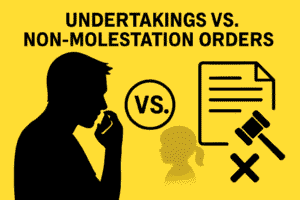Last Updated: Saturday, 6 September 2025
When your relationship with your child’s mother breaks down, the single biggest fear is that your relationship with your children will break down too. The informal agreements you once had can disappear overnight, leaving you feeling powerless and desperate. I have been subjected to significant emotional discomfort when guiding fathers through this exact crisis. The uncertainty is the worst part—not knowing when you’ll see your child again, or what the future holds.
It is crucial to understand that you have a clear legal path to secure your relationship with your child. This is the Child Arrangements Order, and the family court process is the mechanism to get one. It can feel like a daunting mountain to climb, but it is a structured journey with defined steps. As a consultant who has navigated this path with countless fathers, I can tell you that a calm, strategic, and child-focused approach is your most powerful tool. This guide will walk you through the entire process, step-by-step, from the initial application to the final hearing.
Key Takeaways
- A Child Arrangements Order is a legally binding court order that sets out where a child lives and who they spend time with. It provides certainty and enforceability when parents cannot agree.
- The process starts by completing a C100 application form. Before you can do this, you are usually required to attend a Mediation Information and Assessment Meeting (MIAM) to see if you can resolve the dispute outside of court.
- The child’s welfare is the court’s only priority. Your case will be decided based on the Welfare Checklist. All your statements and evidence must be focused on what is in your child’s best interests, not your own.
- The first hearing (FHDRA) is a crucial stage. This is the first time a judge will review your case. It is an opportunity to resolve issues early or to set a clear timetable for how the case will proceed.
Worried about losing contact with your child? WhatsApp us today and get clear guidance on starting your case.
Jump To
- What Is a Child Arrangements Order?
- Step 1: Before You Apply – The MIAM
- A Deep Dive: The C100 Application Form
- The 5 Key Stages of the Court Process
- The Welfare Checklist
- Common Mistakes Fathers Make in the Process
- FAQs: The Child Arrangements Order Process
- Enforcement of a Child Arrangements Order
- Insider Insight from Lach
- Next Steps
What Is a Child Arrangements Order?
A Child Arrangements Order is a legally binding decision made by the family court under Section 8 of the Children Act 1989. It sets out:
- Where your child lives (a “live with” order)
- Who your child spends time with (a “spend time with” order)
- When and how those arrangements take place (e.g. weekends, holidays, handovers)
Its purpose is to give children stability and parents clarity when informal agreements have broken down. Once made, the order is enforceable by the court, meaning either parent can return to court if it isn’t followed.
Step 1: Before You Apply – The MIAM
Before you can ask the court to intervene, the law requires you to consider mediation first. This is done by attending a Mediation Information and Assessment Meeting (MIAM). The purpose is to see if your dispute can be resolved with the help of a neutral mediator, which is faster, cheaper, and less stressful than going to court.
You must attend a MIAM unless you are exempt (for example, if there has been domestic abuse). The mediator will assess whether your case is suitable for mediation. If you or your ex-partner do not wish to mediate, or if the mediator decides it is not suitable, they will sign the relevant part of the C100 form that allows you to proceed with your court application.
A Calm Text Message Proposing Mediation
Here is a practical example of a calm, factual text message you could send to your ex-partner to initiate this process.
“Hi [Ex-Partner’s Name]. I’m really worried that our arrangements for seeing [Child’s Name] have broken down. I think it’s important for [him/her] that we get a clear routine in place. Before we consider court, I’d like to suggest we try mediation to see if we can reach an agreement together. I’m happy to make the arrangements. Let me know what you think.”
A Deep Dive: The C100 Application Form
The C100 form is the formal application that starts the court process for a Child Arrangements Order. This is arguably the most important document you will complete, as it is the first thing the judge and CAFCASS will read about your case.
Official Definition: The C100 is the official court form used to apply for an order under Section 8 of the Children Act 1989. It asks for details about the children, the parents, the nature of the dispute, and what you are asking the court to do. You must also detail any allegations of harm and confirm you have attended a MIAM.
Breakdown of Components:
The C100 form can look overwhelming, but it’s really just a series of sections the court needs to see. Breaking it down helps you understand what each part means for your case and how to complete it strategically.
Section 1: Your Details and the Child’s Details
What This Means For You: This is straightforward factual information. Ensure all names, dates of birth, and addresses are 100% accurate.
Section 5: Why are you making the application?
What This Means For You: This is your first chance to briefly tell the court what has gone wrong. Be concise and factual.
For example: “The mother has stopped all contact since 1st September 2025, having previously agreed to a routine of every other weekend.”
Section 7: Allegations of Harm
What This Means For You: This section is critical. You must disclose if you believe your child is at risk of harm from your ex-partner. Equally, you must be prepared to respond if she makes allegations against you. If there are allegations of domestic abuse, the court will take them very seriously.
Section 13: What you are asking the court to order
What This Means For You: Be clear and specific about the arrangement you believe is in your child’s best interests.
For example: “An order that the child shall live with the mother and spend time with the father every other weekend from Friday after school until Sunday evening, and for half of all school holidays.”
A Real Life Scenario
Mark’s ex-partner has been unreliable with contact, often cancelling at the last minute. He wants to establish a firm routine. In his C100 form, he doesn’t write an angry essay about his ex. In the ‘Why are you applying?’ section, he calmly states: “The informal arrangements for contact have become unreliable, which is causing the child distress and confusion. I am seeking a defined order to provide the child with a predictable and stable routine.” This is child-focused and far more effective.
Common Pitfalls:
Even well-meaning fathers slip up when completing the C100. These are the errors that can delay your case or weaken your credibility – and they’re all avoidable if you know what to watch for.
- Making it an emotional rant: Why this is a mistake: The C100 is a legal document, not a diary. An emotional or aggressive tone will damage your credibility from the start.
- Being vague about what you want: Why this is a mistake: The court needs a clear proposal to work with. Simply saying “I want to see my child more” is not helpful.
- Making mistakes on the form: Why this is a mistake: Incorrect names, dates, or addresses can cause significant administrative delays to your case. Double-check every detail.
The C100 is your foundation — get it wrong and your case is weakened. WhatsApp us now for expert help completing it properly.
The 5 Key Stages of the Court Process
The family court process follows a structured path. Understanding these stages helps you know what to expect and how to prepare.
- Application: You complete and send the C100 form to your nearest family court. The court “issues” (formally starts) the application and sends a copy to your ex-partner, notifying her of the first hearing date.
- CAFCASS Safeguarding: The court automatically notifies CAFCASS. An officer will call you and your ex-partner for a brief safeguarding interview and will run checks with the police and social services. They write a short safeguarding letter to the judge before the first hearing.
- First Hearing (FHDRA): The First Hearing Dispute Resolution Appointment. This is a short hearing where a judge or magistrates will identify the issues, review the CAFCASS letter, and see if any agreement can be reached. If not, they will give “directions” for the next steps, such as ordering statements to be written or a Section 7 report to be prepared by CAFCASS.
- Evidence Gathering & Further Hearings (DRA): This is the period where any reports are written and statements are filed. There may be a second hearing, a Dispute Resolution Appointment (DRA), to review the new evidence and try again to reach an agreement.
- Final Hearing: If you still cannot agree, the case is listed for a Final Hearing. Here, you and your ex-partner will both give evidence and can be cross-examined. The CAFCASS officer may also give evidence. At the end, the judge will make a final, legally binding Child Arrangements Order.
Knowing the stages is one thing — preparing for each step is another. WhatsApp us to make sure you’re always one step ahead in court.
Common Mistakes Fathers Make in the Process
Getting a Child Arrangements Order is a marathon, not a sprint. Many dads damage their case not by what they ask for, but by how they behave along the way. Here are the key mistakes that can set you back.
- Losing your temper. An angry email, a hostile text message, or a heated exchange at a handover can be used as evidence against you. Stay calm and business-like in all communications.
- Focusing on your “rights” instead of your child’s welfare. The court is only interested in what is best for the child. Every argument you make must be through the lens of the Welfare Checklist.
- Not following court directions. If a judge orders you to file a Position Statement by a certain date, you must do it. Failing to comply shows disrespect for the court and can harm your case.
- Bad-mouthing your ex to the children. This is emotionally harmful to your child and will be viewed extremely poorly by CAFCASS and the court. It is a fundamental error.
The Welfare Checklist
Every decision a judge makes about children is guided by the Welfare Checklist in the Children Act 1989. This list of seven statutory factors is the framework the court uses to decide what is in your child’s best interests. Understanding these is crucial to building your case strategically.
- The wishes and feelings of the child (considered in light of their age and understanding).
- The child’s physical, emotional, and educational needs.
- The likely effect on the child of any change in circumstances.
- The child’s age, sex, background, and characteristics that the court considers relevant.
- Any harm the child has suffered or is at risk of suffering.
- How capable each parent is of meeting the child’s needs.
- The range of powers available to the court in the proceedings.
Everything you say in your application, Position Statements, and evidence should be framed through this checklist. It’s the lens the judge is required by law to apply.
FAQs: The Child Arrangements Order Process
Fathers starting this journey often ask these key questions.
What is a Child Arrangements Order?
It is a legally binding court order that sets out who a child lives with (“live with” order) and who they spend time with (“spend time with” order). It replaces the old terms of “residence” and “contact.”
Do I have to go to mediation before applying to court?
Yes, in most cases. You are required to attend a Mediation Information and Assessment Meeting (MIAM) before you can file a C100 application, unless you are exempt (e.g., due to domestic abuse).
How long does it take to get a Child Arrangements Order?
The process can take a long time, often between 6 to 12 months from the date of application to a final order, especially if the court orders a Section 7 report which takes several months to prepare.
What is CAFCASS and what is their role?
CAFCASS is the Children and Family Court Advisory and Support Service. They are independent social workers who advise the family court on what is safe for children and in their best interests. They carry out safeguarding checks and may be asked to write a detailed welfare report.
What happens at the first court hearing (FHDRA)?
The First Hearing Dispute Resolution Appointment (FHDRA) is a short hearing where a judge or magistrates will identify the issues in dispute and see if an agreement can be reached. If not, they will make directions for how the case will proceed.
What is the “Welfare Checklist”?
The Welfare Checklist is a list of seven criteria set out in the Children Act 1989 that a judge must consider when making any decision about a child. Your entire case should be built around this checklist.
What happens if my ex makes false allegations against me?
The court takes allegations of harm very seriously. If there are disputes about facts, the court may decide to hold a fact-finding hearing to determine the truth before making a final decision about child arrangements.
What is a “No Order” principle?
This is a principle from the Children Act that says the court should not make an order unless it is considered better for the child than making no order at all. If parents can agree on a plan, the court will often endorse that rather than imposing a formal order.
How much does it cost to apply for a Child Arrangements Order?
There is a court fee for filing the C100 application. You should always check the official HM Courts & Tribunals Service fees page for the current fee. You may be exempt if you are on a low income.
Can I get legal aid to help with my case?
Legal aid for private family law cases (like applying for a Child Arrangements Order) is very limited. It is generally only available to applicants who can provide specific evidence of domestic abuse or child abuse.
Enforcement of a Child Arrangements Order
Getting an order is only part of the journey. Sometimes, one parent refuses to follow it. The court takes breaches seriously, and there are formal ways to enforce the order.
- Warning notices: Every Child Arrangements Order includes a warning that it must be obeyed. If your ex breaches it, this warning is the first step in enforcement.
- Enforcement orders: The court can order your ex to complete unpaid work (community service) as a sanction for persistent breaches.
- Compensation and fines: If you lost money due to missed contact (e.g., travel costs), the court can order your ex to pay compensation.
- Transfer of residence: In extreme cases, if one parent continually undermines the order, the court can consider changing who the child lives with.
If your ex breaches the order, you must return to court with evidence of the breach. Stay calm and child-focused — judges take enforcement seriously but expect you to approach it reasonably.
Still have unanswered questions? Message us on WhatsApp and we’ll guide you through your situation in plain English.
Insider Insight from Lach
The family court process can feel chaotic and frightening, but it is a process. It has rules, stages, and a clear legal framework. The fathers who achieve the best outcomes are not the ones who shout the loudest, but the ones who understand the journey ahead. They treat it like a marathon, not a sprint. They stay calm, they focus on their child, they meet their deadlines, and they present their case logically. By understanding the path, you take back control.
Meet Lach, Your Guide at Dads Consultancy
Navigating the court process is a marathon, not a sprint. With our fixed-fee support, we can help you prepare for every stage, ensuring you are always one step ahead.
Next Steps
At Dads Consultancy, we provide the specialised, expert support to guide you through every step of the Child Arrangements Order process. Our founder is a former CAFCASS officer who understands the system from the inside and knows what the court needs to see from a father. We can help you with:
- Making Your C100 Application: We provide expert assistance in completing your C100 form flawlessly to make the strongest possible start to your case.
- Handling the CAFCASS Call: We prepare you for the crucial initial safeguarding calls with CAFCASS.
- Drafting Powerful Position Statements: We guide you in writing the clear, concise, and child-focused statements that judges need for every hearing.
- Professional Support for Section 7 Reports: If the court orders a report, we can help you prepare to ensure the officer gets a full and accurate picture.
Your relationship with your child is too important to leave to chance. Taking the first step by making a court application is often the key to restoring certainty and stability. WhatsApp us today for a strategic consultation, and let’s build a clear plan to secure their future with you.
🧠 Insider Insight: Lach, our founder, is a qualified social worker who used to write Section 7 reports for CAFCASS — the very reports that influence court outcomes. Now he helps dads respond to them. Learn more about Lach’s background.
👉 Learn more about how we can support you or book a free consultation today




